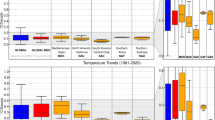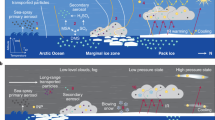Abstract
The Arctic has warmed significantly more than global mean surface air temperature over recent decades1, as expected from amplification mechanisms2,3. Previous studies have attributed the observed Arctic warming to the combined effect of greenhouse gases and other anthropogenic influences4. However, given the sensitivity of the Arctic to external forcing and the intense interest in the effects of aerosols on its climate5,6, it is important to examine and quantify the effects of individual groups of anthropogenic forcing agents. Here we quantify the separate contributions to observed Arctic land temperature change from greenhouse gases, other anthropogenic forcing agents (which are dominated by aerosols) and natural forcing agents. We show that although increases in greenhouse-gas concentrations have driven the observed warming over the past century, approximately 60% of the greenhouse-gas-induced warming has been offset by the combined response to other anthropogenic forcings, which is substantially greater than the fraction of global greenhouse-gas-induced warming that has been offset by these forcings7,8. The climate models considered on average simulate the amplitude of response to anthropogenic forcings well, increasing confidence in their projections of profound future Arctic climate change.
This is a preview of subscription content, access via your institution
Access options
Subscribe to this journal
Receive 12 print issues and online access
$209.00 per year
only $17.42 per issue
Buy this article
- Purchase on Springer Link
- Instant access to full article PDF
Prices may be subject to local taxes which are calculated during checkout



Similar content being viewed by others
References
Christensen, J. H. et al. in Climate Change 2013: The Physical Science Basis (eds Stocker, T. F. et al.) Ch. 14 (IPCC, Cambridge Univ. Press, 2013).
Cohen, J. L., Furtado, J. C., Barlow, M. A., Alexeev, V. A. & Cherry, J. E. Arctic warming, increasing snow cover and widespread boreal winter cooling. Environ. Res. Lett. 7, 014007 (2012).
Screen, J. A. & Simmonds, I. The central role of diminishing sea ice in recent Arctic temperature amplification. Nature 464, 1334–1337 (2010).
Gillett, N. P. et al. Attribution of polar warming to human influence. Nature Geosci. 1, 750–754 (2008).
Arctic Council Task Force on Short-Lived Climate Forcers Recommendations to Reduce Black Carbon and Methane Emissions to Slow Arctic Climate Change (Arctic Council, 2013).
Shindell, D. Estimating the potential for twenty-first century sudden climate change. Phil. Trans. R. Soc. A 365, 2675–2694 (2007).
Bindoff, N. L. et al. in Climate Change 2013: The Physical Science Basis (eds Stocker, T. F. et al.) Ch. 10 (IPCC, Cambridge Univ. Press, 2013).
Jones, G. S., Stott, P. A. & Christidis, N. Attribution of observed historical near-surface temperature variations to anthropogenic and natural causes using CMIP5 simulations. J. Geophys. Res. Atmos. 118, 4001–4024 (2013).
Jones, P. et al. Hemispheric and large-scale land-surface air temperature variations: An extensive revision and an update to 2010. J. Geophys. Res. 117, D05127 (2012).
Flato, G. et al. in Climate Change 2013: The Physical Science Basis (eds Stocker, T. F. et al.) Ch. 9 (IPCC, Cambridge Univ. Press, 2013).
Fyfe, J. C. et al. One hundred years of Arctic surface temperature variation due to anthropogenic influence. Sci. Rep. 3, 2645 (2013).
Hansen, J., Ruedy, R., Sato, M. & Lo, K. Global surface temperature change. Rev. Geophys. 48, RG4004 (2010).
Myhre, G. et al. in Climate Change 2013: The Physical Science Basis (eds Stocker, T. F. et al.) Ch. 8 (IPCC, Cambridge Univ. Press, 2013).
Allen, M. & Stott, P. Estimating signal amplitudes in optimal fingerprinting, Part I: Theory. Clim. Dynam. 21, 477–491 (2003).
Ribes, A., Planton, S. & Terray, L. Application of regularised optimal fingerprinting to attribution. Part I: Method, properties and idealised analysis. Clim. Dynam. 41, 2817–2836 (2013).
Smith, T. M., Reynolds, R. W., Peterson, T. C. & Lawrimore, J. Improvements to NOAA’s historical merged land–ocean surface temperature analysis (1880–2006). J. Clim. 21, 2283–2296 (2008).
Hartmann, D. L. et al. in Climate Change 2013: The Physical Science Basis (eds Stocker, T. F. et al.) Ch. 2 (IPCC, Cambridge Univ. Press, 2013).
Stieglitz, M., Déry, S., Romanovsky, V. & Osterkamp, T. The role of snow cover in the warming of arctic permafrost. Geophys. Res. Lett. 30, 1721 (2003).
Kay, J. E., Holland, M. M. & Jahn, A. Inter-annual to multi-decadal Arctic sea ice extent trends in a warming world. Geophys. Res. Lett. 38, L15708 (2011).
Parkinson, C. L. & Comiso, J. C. On the 2012 record low Arctic sea ice cover: Combined impact of preconditioning and an August storm. Geophys. Res. Lett. 40, 1356–1361 (2013).
Shepherd, A. et al. A reconciled estimate of ice-sheet mass balance. Science 338, 1183–1189 (2012).
Gillett, N. P. & Von Salzen, K. The role of reduced aerosol precursor emissions in driving near-term warming. Environ. Res. Lett. 8, 034008 (2013).
Collins, M. et al. in Climate Change 2013: The Physical Science Basis (eds Stocker, T. F. et al.) Ch. 12 (Cambridge Univ. Press, 2013).
Hasselmann, K. Multi-pattern fingerprint method for detection and attribution of climate change. Clim. Dynam. 13, 601–611 (1997).
Acknowledgements
We acknowledge the Program for Climate Model Diagnosis and Intercomparison and the World Climate Research Programme’s Working Group on Coupled Modelling for their roles in making the WCRP CMIP5 multi-model data sets available. This work is supported by the NSERC Canadian Sea Ice and Snow Evolution (CanSISE) Network.
Author information
Authors and Affiliations
Contributions
M.R.N., F.W.Z. and N.P.G. designed analysis. M.R.N. conducted the analysis and wrote the initial draft. F.W.Z. and N.P.G. helped with the analysis and edited the manuscript.
Corresponding author
Ethics declarations
Competing interests
The authors declare no competing financial interests.
Supplementary information
Rights and permissions
About this article
Cite this article
Najafi, M., Zwiers, F. & Gillett, N. Attribution of Arctic temperature change to greenhouse-gas and aerosol influences. Nature Clim Change 5, 246–249 (2015). https://doi.org/10.1038/nclimate2524
Received:
Accepted:
Published:
Issue Date:
DOI: https://doi.org/10.1038/nclimate2524
This article is cited by
-
Anthropogenic impact on the severity of compound extreme high temperature and drought/rain events in China
npj Climate and Atmospheric Science (2023)
-
Historical global ocean wave data simulated with CMIP6 anthropogenic and natural forcings
Scientific Data (2023)
-
Relative contributions of internal variability and external forcing to the inter-decadal transition of climate patterns in East Asia
npj Climate and Atmospheric Science (2023)
-
Seasonally distinct contributions of greenhouse gases and anthropogenic aerosols to historical changes in Arctic moisture budget
npj Climate and Atmospheric Science (2023)
-
Quantifying contributions of ozone changes to global and arctic warming during the second half of the twentieth century
Climate Dynamics (2023)



